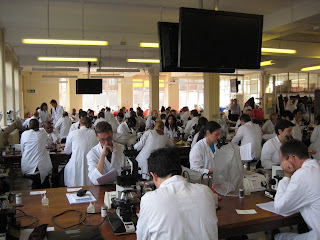
is not a topic that was taught in my medical education prior to this course. I'm sure about this, as it is the kind of thing that I would certainly remember. Here in Liverpool, we spent a whole precious day on myiasis. Medical Entomology for Students is on my bedside table.
Myiasis refers to the invasion of mammalian tissue by fly larvae (more commonly known as maggots). There are many species of fly larvae that cause myiasis, some of which burrow deep into healthy tissue and some of which infect already necrotic tissue.
I will not post any gross pathology pics of maggots in human tissues, as I know that it's not the kind of thing that everybody likes to study as much as I do. At left is a light microscopy image of an ear infected by Dermatobia hominis (human bot fly) larvae, which is endemic to Central and South America. [The larvae are the three yellowish cone-shaped structures buried in the pink ear tissue.] The botflies have evolved an ingenious way to infect their hosts. They lay sticky eggs which glue onto the bodies of biting insects (e.g mosquitoes). The eggs drop off onto the tissue of human hosts when the carrier takes a blood meal.
Apparently there has been a recent upsurge in interest in "maggot therapy" in developed countries. This therapy uses sterile (lab-grown) larvae of Callifora and Lucilia species (bluebottle and greenbottle blowflies) as a means to debride chronic wounds. Again, I will spare you pics. For additional reading: Parnes, A et al "Larval therapy in wound management: a review." Int J Clin Pract, 61, 488-93.









